List of common and exotic shells found in San Carlos Mexico. Interesting Marine Life also comes in small packages in the Gulf of California (Sea of Cortez). Discover the variety, shape and color of these shells … you can find them all while diving, snorkeling and walking the beaches in San Carlos Sonora.
What is a shell?
Simply, without being pedantic, “shells” comprise five main classes of marine life; Gastropods, Bivalves, Tusk Shells, Chitons, and Cephalopods. Our entries in the Konch Korner have and will continue to deal primarily with gastropods and bivalves. So … exactly what is a shell you may well ask.
As most of you who are interested in shells already know, shells are usually hard, as they are made up of a basic material identified as calcium carbonate and conchiolin. These substances, produced from an egg, tiny larva, which swims, floats, for sometimes months on end and finally settles to the bottom, are what form the shell as it lies peacefully on the body and matures into a hardened surface and continues its growth to maturity, becoming what we know as a mollusk, a soft animal with a hard-house around it. And so it is my friends, a shell, by any other name, is still a shell!
What is a gastropod?
No, not something that happens after eating or drinking too much too fast for dinner. A gastropod is one of the main five classes of shells/mollusks. The term ‘gastropod’ refers to the fact that this particular shell has a significant foot aperture. This ‘foot’ varies in size, shape, and functionality and is the shell’s main means of both transportation, and, in many cases, defense. The foot can be flat and smooth, with an operculum (trap door) which can be closed into the shell for protection, or at the end of the foot there can be a large claw which can cut, fight, and move the shell very rapidly. These ‘footed’ gastropods are often simply algae kelp grazers, and just as frequently carnivorous predators feeding on other mollusks.
The preceding descriptions are, certainly, abbreviated. For an in-depth and fascinating study of shell refer to the Keen works, “Sea Shells of Tropical West America”.
Black Murex (Muricidae)
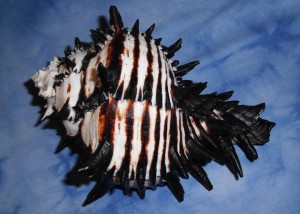 Shell: Black Murex, a mollusk /gastropod (foot, or false foot) member. It is black and white, quite beautiful and easily obtainable for shell enthusiasts. The Black Murex is quite large and oblong with distinct black spines.
Shell: Black Murex, a mollusk /gastropod (foot, or false foot) member. It is black and white, quite beautiful and easily obtainable for shell enthusiasts. The Black Murex is quite large and oblong with distinct black spines.
The one in the photo was found at 40 feet of water in San Carlos. It measures 6 3/4 inches in length and 5 ½ inches in height/width.
The murex feeds primarily on clams by inserting their little proboscis (nose/horn) into the edge of the clam opening and sucking out the juice. Yeah, I know… yuck. Apparently they also have a taste for caviar.
This shell is pretty much confined to the Gulf of California (Sea of Cortez) and is fairly abundant and plentiful. Find a fish camp and there will be many to choose from. In the water environment they are readily found in reef areas both shallow and deep. Personally, the black murex is one of my favorites and cleans up, with a little patience and work, quite nicely and is well preserved with a light spray of baby oil once or twice a year to maintain a natural yet bright patina.
False Triton
 Shell: False Triton, from the family Cymatiidea, genus Cymatium, sub-genus Cymatium parthenopeum keenea.
Shell: False Triton, from the family Cymatiidea, genus Cymatium, sub-genus Cymatium parthenopeum keenea.
While this specimen is reported to be reasonably available from La Paz, Gulf of California, Sea of Cortez to Negritos, Peru, we have personally encountered only three perfect specimens. Its range of habitat is said to run intertidally and offshore, though our encounters have been in depths of 60 to 80 feet.
It feeds on bivalves by anesthetizing its prey with an acid fluid.
This is another one of those ‘hide-by-looking-like-a-small-hairy-rock, covered with a brownish scruffy fiber, or periostracum’ shells. These shells grow to 4-5 inches in length and about 2 to 2 1/5 inches in height and width. Beach specimens we have encountered have usually been pretty banged up or damaged as well as sun-bleached and have been located at the beaches, both north and south, of Isla Venado (Deer Island) in front of the Soggy Peso and Paradiso Hotel.
Ear Conch, Angel Conch, or Winged Conch (Strombus peruvianus)
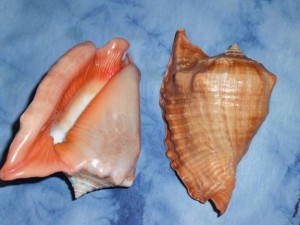 Shell: Ear Conch, Angel Conch, or Winged Conch (Strombus peruvianus). These beautiful shells are abundant and partially migratory/seasonal, i.e., there are virtually hundreds of them during the warm water months, less plentiful during the cold water months. The Strombus peruvianus is another member of the Strombidae family (Phylum-Mollusk, Class-Gastropoda).
Shell: Ear Conch, Angel Conch, or Winged Conch (Strombus peruvianus). These beautiful shells are abundant and partially migratory/seasonal, i.e., there are virtually hundreds of them during the warm water months, less plentiful during the cold water months. The Strombus peruvianus is another member of the Strombidae family (Phylum-Mollusk, Class-Gastropoda).
The living species have a large ‘hook’ on the extended portion of the ‘foot’ of the body and is able to transport itself with the use of the hook and foot method. Keen wrote that “The foot facilitates an unusual mode of locomotion for a gastropod”… in that “instead of the normal gliding motion, there is a scrambling or leaping, with the pointed ‘hook’ operculum used as a sort of claw.” Keen also notes that the peruvianus have complex eyes, “keener than in most other gastropod groups” using one eye while feeding and the other for detecting predators. She also notes that these critters are herbivorous, grazing on bottom deposits and algae. The ‘winged conch’ can reach lengths of 150 mm (6-7 inches) or more and the females tend to be larger than the males.
These conchs are listed as living in the waters from Marias Islands, Mexico, to Northern Peru.
Our own experience is that peruvianus are very well camouflaged under a thick, dark brown periostracum (a hairy fibrous brown hiding place). Most divers swim over and around them, sight unseen as they basically look like rocks or lumps in the water. Local to San Carlos, sightings have included the areas of Las Gringas, Punto Lobo, Isla Ventana, and Punto San Francisco in depths of 40 to 80 feet.
The peruvianus is considered a delicacy by panga divers and local fish netters. They have a body texture similar to the King and Queen Conch. Harvested specimens can often be procured at local fish camps and villages, though many of these shells have been broken, or ‘punched-in’ to obtain the meat inside. Sometimes you may see abandoned shells in sand traps or caverns. As always, we urge folks to be sensitive to the environment and not molest these shells if they are occupied.
Spondylus calcifer (white thorny oyster)
 Shell: we believe this to be the Spondylus calcifer (white thorny oyster) described by Keen (1992) as being the largest of all specimens in the Spondylus group. This shell, if indeed the calcifer, fits her description of being very large and heavy and in fact is 5 ¼ inches across, and 6 inches in length, with an original weight of almost 2 pounds. As can be seen, the rows are distinct and have considerable margin for the Spondylus and the teeth on this critter actually overlap the top and bottom side. The name calcifer (lime-bearer) according to Keen indicates its use historically as a source of lime, used to create cement for Spanish settlers in Central America and later found in Amerind grave sites in Eastern Mexico.
Shell: we believe this to be the Spondylus calcifer (white thorny oyster) described by Keen (1992) as being the largest of all specimens in the Spondylus group. This shell, if indeed the calcifer, fits her description of being very large and heavy and in fact is 5 ¼ inches across, and 6 inches in length, with an original weight of almost 2 pounds. As can be seen, the rows are distinct and have considerable margin for the Spondylus and the teeth on this critter actually overlap the top and bottom side. The name calcifer (lime-bearer) according to Keen indicates its use historically as a source of lime, used to create cement for Spanish settlers in Central America and later found in Amerind grave sites in Eastern Mexico.
This specimen, however, found at a depth of 120 feet, off of San Pedro Nalasco Island, was nestled in an area that was largely coral waste and sand. The range of the ‘calcifer’ is from the Sea of Cortez to Ecuador. Our only doubt on this shell was that it lacked the inner band of color of which Spondylus is notorious for, though a few species, i.e. the Spondylus princeps unicolor, which is also toothed or spiny, sometimes has no inner band, and can be found from Concepcion Bay, Sea of Cortez down to Jalisco, Mexico in depths of 7 to 30 meters. Again, the above specie was taken from 120 feet or roughly 40 meters.
Double-banded moon shell
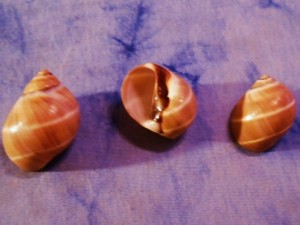 This shell has some rather unique qualities compared to the other gastropod shells. These shells are from the Family ‘Naticidae’, sub-genus, ‘Polinices’ and specie, ‘Polinices bifasciatus’. For the rest of us, it’s a double-banded moon shell (so named because of its nice warm brown to yellow background color which is offset by two distinct white bands).
This shell has some rather unique qualities compared to the other gastropod shells. These shells are from the Family ‘Naticidae’, sub-genus, ‘Polinices’ and specie, ‘Polinices bifasciatus’. For the rest of us, it’s a double-banded moon shell (so named because of its nice warm brown to yellow background color which is offset by two distinct white bands).
One of the very unique qualities of this shell, which separates it from the other gastropods, is that it’s not a ‘keep on sucking’, nor ‘poisoner’ type but rather a ‘driller’. This is indeed a unique quality in the gastropod class. Earlier on, folks thought that it also emitted an acid to aid in drilling but according to Keen (1992, p. 472) some species emit an enzyme that assists in removing loose particles during the drilling process. The drilling is accomplished by a ‘radula’ which this group conveniently carries inside itself (i.e., a neat little drill-saw). The holes are consistent with a drill and evidence has shown that sometimes it takes 1-3 holes before the shell hits its mark. This shell protects itself with a horny operculum (spiked front door) and just keeps on drilling until tired, knocked off, or eaten by a predator. They are patient, however, and may drill several holes before hitting the vulnerable area of its prey, clams, limpets, murex, etc.
According to Morris (1980, p .167), the double-banded moon shell reaches a height of about an inch and a half (though we’ve encountered some as large as two inches), and has a range from the Sea of Cortez to Panama. Their habitats are usually shallow water in sand and/or mud. This is also a great beachcomber shell and tide-pooler, usually in pretty good to fair condition (please be sure they are uninhabited) and can be found, just walkin along, singing a song, lookin for shells.
Button cowrie
 The button cowrie, a.k.a, Jenneria postulate of the Family Cypraeidea (some 170 species), sub-family Eocypraeinae, of which only 7 are given to the Panamic region and only 2 within this group that deviate from the rest of the genera with distinguished sculpted surfaces including, nodes and/or ribs. As notes Keen (1992, Sea Shells of the Tropical West Americas, p. 497) “this species can be confused with no other living species on earth” The Button cowries run about ¾” to 1 inch in length and ½ “ in width and can be found in the intertidal zones to 60 feet. They are abundant after large storms and hurricanes, but with patience one can find them along the beaches within rocky crevices where there is sand. Beach finds are almost always uninhabited, though one should use caution in this.
The button cowrie, a.k.a, Jenneria postulate of the Family Cypraeidea (some 170 species), sub-family Eocypraeinae, of which only 7 are given to the Panamic region and only 2 within this group that deviate from the rest of the genera with distinguished sculpted surfaces including, nodes and/or ribs. As notes Keen (1992, Sea Shells of the Tropical West Americas, p. 497) “this species can be confused with no other living species on earth” The Button cowries run about ¾” to 1 inch in length and ½ “ in width and can be found in the intertidal zones to 60 feet. They are abundant after large storms and hurricanes, but with patience one can find them along the beaches within rocky crevices where there is sand. Beach finds are almost always uninhabited, though one should use caution in this.
As can be seen from the photo, the dorsum (top) is covered with orange postulates (buttons/protrusions) and the base is lined with white ridges to teeth at the interior and light brown to black indentations between the ridges. This is a fascinating family in that it is one of very few where the females of some of the species, upon laying their egg nests, stay to protect the young and even make threatening gestures against predators, a rather unique behavior among the gastropod family.
Pacific Coast Spiny Oyster (Spondylus Princeps)
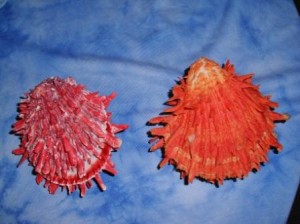 We’d like to present a member of one of the other five classes in the mollusk family, a bi-valve by any other name, the Spondylus Princeps, or in layman terms, the Pacific Coast Spiny Oyster, or in Spanish, the almeja espina (spiny clam). This species is reasonably rare from a very small group of only 40 species in all tropical seas with 3 species in the Atlantic and West Indies and only 2 residing on the Pacific Coast, or Sea of Cortez to Ecuador. These little puppies can be found in depths of 5-40 meters or 15-120 feet. They are usually attached to rocks, coral, or even other shells. We have one specimen that actually made its home on the back of a very large Lions Paw Scallop. Colors run from pure white, to mixes of yellows, pinks, oranges and reds.
We’d like to present a member of one of the other five classes in the mollusk family, a bi-valve by any other name, the Spondylus Princeps, or in layman terms, the Pacific Coast Spiny Oyster, or in Spanish, the almeja espina (spiny clam). This species is reasonably rare from a very small group of only 40 species in all tropical seas with 3 species in the Atlantic and West Indies and only 2 residing on the Pacific Coast, or Sea of Cortez to Ecuador. These little puppies can be found in depths of 5-40 meters or 15-120 feet. They are usually attached to rocks, coral, or even other shells. We have one specimen that actually made its home on the back of a very large Lions Paw Scallop. Colors run from pure white, to mixes of yellows, pinks, oranges and reds.
As you can readily see from the above photograph, the spines vary in length and are very delicate. Again note, there is a very nice band of color on the inside lining of the shell. Some species can reach lengths of 150 mm to 100 mm in width. While labor intensive to clean and preserve, this shell, without a doubt, is a wonderful collector’s item. Specimens can sometimes be found in fish/dive panga camps where they become entangled in nets. We have also encountered several of these species on the 3 Paradiso Reefs in front of the Paradiso Hotel in reasonably shallow water.
Fig Shell (Ficus Ventricosa)
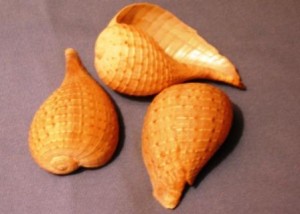 This week’s feature is the Ficus Ventricosa, aka the Fig Shell. The word ‘ficus’ is from the Latinus-Jivas, meaning, fig, and as notes Keen (1992 2nd edt.), is one of the very few feminine endings i.e. ‘us’ that occur, as is the Venus specie. Also as notes Keen/Lamarck, it is synonymous with Pyrula which means ‘little pear, an apt description for this specie.
This week’s feature is the Ficus Ventricosa, aka the Fig Shell. The word ‘ficus’ is from the Latinus-Jivas, meaning, fig, and as notes Keen (1992 2nd edt.), is one of the very few feminine endings i.e. ‘us’ that occur, as is the Venus specie. Also as notes Keen/Lamarck, it is synonymous with Pyrula which means ‘little pear, an apt description for this specie.
This beautiful specimen, from the Ficidae Family, still a member of the gastropod family, is an extremely paper-thin shelled critter that is difficult to find intact. While not totally uncommon on beaches, it can be found intact in some shallow off-shore areas such as the Palapa, north of La Manga. The shell is a tan color with delicate brown to black spots. The Ficus Ventricosa is in fact plentiful and ranges from Baja California, the Sea of Cortez and down to Peru. This shell measures around 3½ to 4 inches in height to 4 to 5 inches in length.
If you are lucky enough to obtain an intact (and uninhabited please) specimen, we recommend you gently apply baby oil to the surface every three months or so to maintain the shell’s polish and integrity.
Chocolate Conch (Melonga patula)
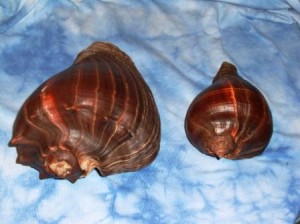 This week’s specimen is from the Melongenidae Family, a group of large pear-shaped shells that vary somewhat in banding and color but are typically dark, or chocolate colored and usually, as seen above, though not always, banded. This shell, the Melonga patula, or chocolate conch, often has horns, or spikes on the upper part of the shell, though some do not. This critter is a second cousin to the Queen conch in that it uses a spike-like claw for mobility and securing dinner (other shell critters usually).
This week’s specimen is from the Melongenidae Family, a group of large pear-shaped shells that vary somewhat in banding and color but are typically dark, or chocolate colored and usually, as seen above, though not always, banded. This shell, the Melonga patula, or chocolate conch, often has horns, or spikes on the upper part of the shell, though some do not. This critter is a second cousin to the Queen conch in that it uses a spike-like claw for mobility and securing dinner (other shell critters usually).
The adult shell can reach lengths of up to 10 inches and widths/heights 4-5 inches, though the more common occurrence here in San Carlos is in the range of 6-8 inches in length. The range of this shell is from Sea of Cortez to Panama and they tend to hang out in mudflat areas and sand in depths ranging from 9 -60 feet. This is a highly sought-after shell by locals as a food source and is often obtained by local drag-net fishermen and commercial divers. A good source for this shell is local fish-camps and desert shell-dumps above La Manga. This shell is not uncommonly found in souvenir shops as well. The above pictured shell was obtained in 12 feet of water a little south of La Manga and in front of the Paradiso Hotel on a 250 to 330 degree course.
Preservation and patina on this shell also includes the application of baby oil. We massage the baby oil into the shell about every three to four months. If you have questions about this shell or preservation/cleaning applications please feel free to contact us at 622-116-1014 or alchip692@msn.com. Thanks for the feedback and interest.
Sand Dollars
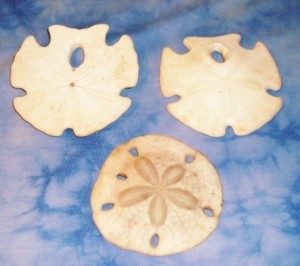 This week’s article is about two Sand Dollars, both from the Class: Echinoid, Family Echinodermata. The two sand dollars pictured are in the Encope grandis specie, known locally, as are all sand dollars by locals, as the ‘Galleta del Mar, or the cookie sand dollar. The lower rounded sand dollar is of the Encope micropora specie. Other names for the above Encope grandis include the Irish Charm or Five Fingered sand dollar.
This week’s article is about two Sand Dollars, both from the Class: Echinoid, Family Echinodermata. The two sand dollars pictured are in the Encope grandis specie, known locally, as are all sand dollars by locals, as the ‘Galleta del Mar, or the cookie sand dollar. The lower rounded sand dollar is of the Encope micropora specie. Other names for the above Encope grandis include the Irish Charm or Five Fingered sand dollar.
Interestingly enough, the sand dollar is related to the sea urchins and sea stars according to Betty Hupp and Marilyn Malone (The Edge of the Sea of Cortez, p.78, 2008). The live specimen is covered in tiny spines, or Cilia (hairs) and they use these spines both for mobility and obtaining food which usually consists of organic particles. Even more fascinating is that they do so by burying themselves halfway in the sand on edge with their bottom portion facing the current, and then use the spines to move the edible materials towards their mouths in the center of the bottom (note the hole in bottom of the upper left shell in the photo). Colors range from light brown to dark purple and the Irish Charm’s diameter ranges from 4-5 inches and the rounded specie from 5-6 inches. The ‘test’ or dead sand dollars are usually brownish to white and can be found in tide pools and shallow sandy beaches with a distribution from throughout the Gulf and north to Bahia Magdalena to depths of 150 feet.
The inside of each sand dollar contains 7 bones which are referred to as ‘doves’ and do in fact look very similar to white doves. The primary antagonists to the sand dollar are sand sharks and rays, but if minimal damage is incurred, they can regrow their Celia/spines and survive. These specimens were obtained from the beach area north of Deer Island (Isla Venado). These lil’ cookies are generally plentiful and migratory and in fact are inward bound currently, so keep a close lookout while snorkeling or diving as the uninhabited species are difficult to spot from the surface.
Horse Conch (Pleuroploca princeps)
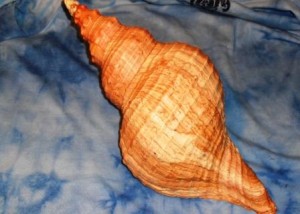 This week’s article is about the fascinating specie Pleuroploca princeps, otherwise known as the Horse Conch, Chile conch and orange tulip conch, and resides, again, in the gastropod family. This shell can get up to 15-16 inches and is considered to be the largest of the Panamic gastropod family. The specimen depicted above is a mere 13 ¼ inches and was obtained by local diver/fishermen from the pueblo La Manga. They found it in about 60 feet of water in front of Isla Venado (Deer Island), in the canyon in front of the island, north of Soggy Peso and a bit south of Paradiso Resort. This little beastie feeds on other gastropods and has a particular appetite for Hexaplex erythrotumus (see earlier articles) or the pink and/or brown caracoles displayed in earlier newsletters.
This week’s article is about the fascinating specie Pleuroploca princeps, otherwise known as the Horse Conch, Chile conch and orange tulip conch, and resides, again, in the gastropod family. This shell can get up to 15-16 inches and is considered to be the largest of the Panamic gastropod family. The specimen depicted above is a mere 13 ¼ inches and was obtained by local diver/fishermen from the pueblo La Manga. They found it in about 60 feet of water in front of Isla Venado (Deer Island), in the canyon in front of the island, north of Soggy Peso and a bit south of Paradiso Resort. This little beastie feeds on other gastropods and has a particular appetite for Hexaplex erythrotumus (see earlier articles) or the pink and/or brown caracoles displayed in earlier newsletters.
This shell is one of the biggest and most aggressive of the Panamic conch and, as can be seen, has a beautiful orange to red exterior. The range of the Chile/Horse conch runs from the Sea of Cortez to Peru and is fairly abundant from depths of 60 to 100 feet and prefers to travel in a mixture of sand adjacent to rocky areas where there is food. According to Keen (1992), there are similar shells, though different species in the Atlantic and Caribbean oceans. The value of this particular specimen is the meat inside which is 90% edible and some say, similar in texture and taste to the abalone, though that has not been my experience. These shells are extremely difficult to come by and because of their edibility are often broken into from behind to release the contents. This shell pictured has been preserved without damage, which is extremely unusual. Interestingly enough, this species is not susceptible to the wiles of other prey including the octopus, as it can exert an enormous amount of pressure against its closing aperture, an extremely hard cast operculum (hard case door, brown and thick). The same is true of predatory star-fish, which are also frustrated by the operculum’s pressure maintenance.
As per most shells, this one was soaked in pure Clorox in a sealed container to remove the debris and calcium build-up on the outside. Baby oil was used to preserve the patina in its natural state and enhance the calcium of the shell
Common Hairy Triton
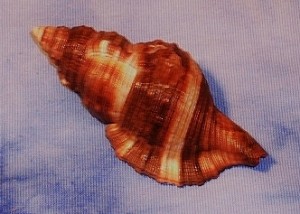 This week’s presentation is another specie in the Triton, or Tonnoidea, family referenced as the Common Hairy Triton (though it’s not that common). Specimens are not that abundant, though Dance and Keen both refer to it as a shallow water rocky/coral dweller. The shell is very sturdy and thick and can hold up to waves, sun, and beach abuse but are not that plentiful in this part of the Sea of Cortez. This specimen was found in 40 feet of water in an area of both rock and sand. Like its cousin, the False Triton, (see previous Konch Korner article) it preys on bivales, which are abundant here, by anesthetizing their dinner with an acid fluid.
This week’s presentation is another specie in the Triton, or Tonnoidea, family referenced as the Common Hairy Triton (though it’s not that common). Specimens are not that abundant, though Dance and Keen both refer to it as a shallow water rocky/coral dweller. The shell is very sturdy and thick and can hold up to waves, sun, and beach abuse but are not that plentiful in this part of the Sea of Cortez. This specimen was found in 40 feet of water in an area of both rock and sand. Like its cousin, the False Triton, (see previous Konch Korner article) it preys on bivales, which are abundant here, by anesthetizing their dinner with an acid fluid.
The range of these shells is, however extensive, ranging from the Sea of Cortez to Manzanillo to Panama and the Galapagos Islands, and according to Keen (1992) northern parts of Peru. The length of these little critters is from 2 to 4 inches in length and at its widest point about 1 to 2 inches. This is another of those shells that basically looks like a rock or stone underwater and is thickly covered (looking like a fur ball). You really have to keep the mask cleared and eyes open to spot them. Their natural predators are other conch and octopus.
In cleaning this specie, it is usually sufficient to put them in a sealed container of pure Clorox for about 36 to 48 hours to remove the fur ball.
Tellina radiata
 Welcome back to the Shell Corner and this week’s somewhat confounding Tellina radiata, or Tellina zacae (Keen, 1992, plate 552, p.225, Sea Shells of Tropical West America, edt. 2), depending on which author you believe is the more accurate. It’s also known as the Sunrise Tellin. Hupp and Malone in “The Edge of the Sea of Cortez”, refer to this shell, and the general family of Tellin, simply as Tellina, or “Almeja Telina” which somewhat understates the vastness and variety of the Tellin family. Keen, we believe, correctly asserts that this shell is a sub-genus of the Tellinadae Family. There has been little study done on it and only a very few specimens to observe short of a few dredging stations in the southwestern part of the Gulf of California. The Tellinadae family consists of many genera and several hundred species.
Welcome back to the Shell Corner and this week’s somewhat confounding Tellina radiata, or Tellina zacae (Keen, 1992, plate 552, p.225, Sea Shells of Tropical West America, edt. 2), depending on which author you believe is the more accurate. It’s also known as the Sunrise Tellin. Hupp and Malone in “The Edge of the Sea of Cortez”, refer to this shell, and the general family of Tellin, simply as Tellina, or “Almeja Telina” which somewhat understates the vastness and variety of the Tellin family. Keen, we believe, correctly asserts that this shell is a sub-genus of the Tellinadae Family. There has been little study done on it and only a very few specimens to observe short of a few dredging stations in the southwestern part of the Gulf of California. The Tellinadae family consists of many genera and several hundred species.
So, having said all that, we’re going with “Sunrise Tellin” or for those of you with a sense of humor, the Tequila Sunrise! And, as we noted of Keen’s work last week, and the confusion surrounding this shell, we have, as can be seen in the photo, placed the Sunrise and the Rose Petal together in the hope of creating more clarity and less confusion. As can easily be seen what few bands that can be established on the Sunrise, are almost triangular and distinctly patterned running vertically down the slope of the surface. The Rose petal on the other hand, of the few variations in bands that are noticeable, run horizontal to the plane of the shell.
Both of the pictured shells were collected from beach drifts on sandy beaches such as Cochorit (just south of Empalme) though are reported to be found as deep as 60 to 70 feet. Both seem to prefer sandy bottoms for homing areas and are detritus feeders. The Tellin sunrise pictured measures 1 ½ inches in length and 1 inch in width.
Giant Spindle shell
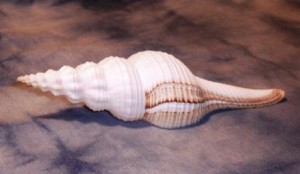 Our shell this week is the Giant Spindle shell, of the Latinus jivas (jive Latin) family Fasciolariidae, sub-family Fusinus, and known in technical terms as the “Fusinus dupetitthouarsi” or sometimes as Du Petit’s Spindle (Dance, S. Peter, 2002, p.153 ). The giant spindle is another member of the Gastropod Class. According to Keen (1992, pp. 610, 616) and this spindle shell, there are two genera in the two Panamic families and was first classified by Kiener in 1840. So … enough about the technicalities.
Our shell this week is the Giant Spindle shell, of the Latinus jivas (jive Latin) family Fasciolariidae, sub-family Fusinus, and known in technical terms as the “Fusinus dupetitthouarsi” or sometimes as Du Petit’s Spindle (Dance, S. Peter, 2002, p.153 ). The giant spindle is another member of the Gastropod Class. According to Keen (1992, pp. 610, 616) and this spindle shell, there are two genera in the two Panamic families and was first classified by Kiener in 1840. So … enough about the technicalities.
As can be seen in the photo, this specie of spindle is white and is one of the longest of its genus measuring up to 10 inches, though the above specimen is only 7 inches long and 2 inches wide. The most distinctive feature of this particular spindle is the distinct ribbing in the spiral and axial whorl which tops out into an extremely fine tip. The second feature that separates it from its cousins are the distinct light to dark brown streaks moving from the shoulder to the siphonal canal (base of the column). When first encountered, living shells are covered with a green to yellow perioscum/algae and also present an operculum (closed door hatch) for protection.
These beautiful shells can often be found intact and sound on sandy beaches. They tend to reside in sandbars and mud flats at extreme low tide levels and offshore to about 150 feet. You can also encounter many of these cuties, uninhabited, in sandy back washes in relatively shallow water areas. This particular shell was found off the beach in front of La Manga. Their range runs from Baja California, the Sea of Cortez and as far south as Ecuador.
In terms of cleaning these shells, preferably uninhabited, soak them in a sealed container of pure Clorox for about 24-48 hours.
Solander’s trivia
 Today’s shell: sub-genus Pusula, “Solander’s trivia”, or, Trivia (Pulsula) solandri, of the genus Trivia, and Family Triviidae. Much like last week’s presentation of the Button Cowrie, Solander’s trivia (see photo) is common to the Sonoran coast and can be readily found on beaches here after strong storms or hurricanes. Length ranges from ½ inch to 1 inch. Its normal habitat is under inter-tidal and sub-tidal rocks and crevices to depths of 60 feet. The range of this shell, however, is throughout the Sea of Cortez to Peru, and, from southern California to Cabo San Lucas. Again, it should be noted that the Sonoran coast is the metro-area for these shells. The pictured shells were collected from the Palapa Beach area north of La Manga in the sandy/rocky areas and kelp traps above the water-line.
Today’s shell: sub-genus Pusula, “Solander’s trivia”, or, Trivia (Pulsula) solandri, of the genus Trivia, and Family Triviidae. Much like last week’s presentation of the Button Cowrie, Solander’s trivia (see photo) is common to the Sonoran coast and can be readily found on beaches here after strong storms or hurricanes. Length ranges from ½ inch to 1 inch. Its normal habitat is under inter-tidal and sub-tidal rocks and crevices to depths of 60 feet. The range of this shell, however, is throughout the Sea of Cortez to Peru, and, from southern California to Cabo San Lucas. Again, it should be noted that the Sonoran coast is the metro-area for these shells. The pictured shells were collected from the Palapa Beach area north of La Manga in the sandy/rocky areas and kelp traps above the water-line.
Miter (Atrimeitra, the Belcheri)
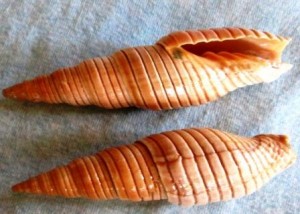 This week’s shell is from the Matridae Family, genus Mitra, sub-genus Atrimeitra, the Belcheri, commonly grouped in the Miter family (pronounced ‘might’). This shell is one of the largest of the Miter group and is a much sought after collector’s item. The pictured shell, measures 3 ½ inches in length and about 1 ½ inches in width at its widest point, and is a whitish to peach/pink color. Most of these shells can only be collected by deep divers and dredge boats due to the fact that they are a reasonably deep (90+ foot) dweller. They can be obtained in fish/panga camps. The range of this lovely critter runs from off Magdalena Bay, Baja California and Mazatlan to Panama. When first obtained this shell is covered by a thin green to black skin, but, after about 24 hours in pure Clorox in a sealed container, the result, is the pictured shell. Very little in our extensive library lends a clue as to either its eating or reproduction traits.
This week’s shell is from the Matridae Family, genus Mitra, sub-genus Atrimeitra, the Belcheri, commonly grouped in the Miter family (pronounced ‘might’). This shell is one of the largest of the Miter group and is a much sought after collector’s item. The pictured shell, measures 3 ½ inches in length and about 1 ½ inches in width at its widest point, and is a whitish to peach/pink color. Most of these shells can only be collected by deep divers and dredge boats due to the fact that they are a reasonably deep (90+ foot) dweller. They can be obtained in fish/panga camps. The range of this lovely critter runs from off Magdalena Bay, Baja California and Mazatlan to Panama. When first obtained this shell is covered by a thin green to black skin, but, after about 24 hours in pure Clorox in a sealed container, the result, is the pictured shell. Very little in our extensive library lends a clue as to either its eating or reproduction traits.
Harp Shell Family
 This week’s shell is the Harp Shell Family, Harpidae, genus Harpa, and the Harpa erenata shell above which is the only known species in the Panamic region. According to Keen (1992, Sea Shells of Tropical West America pg. 620, the Harp Shells, “have not dispersed into the Caribbean or the Atlantic”. As can be seen in the photo the aperture (opening) is very wide with a notched canal at the base. There is also no operculum (hatch door) attached to this shell. This shell could almost be confused with the Ficus Ventricosa, or Fig Shell, presented in the Konch Korner last year. The two notable differences are that the ribs of the Harp run vertically while the Fig ribs run horizontally. Secondly, the Harp is a much sturdier thicker shell compared to the delicate thin Fig shell.
This week’s shell is the Harp Shell Family, Harpidae, genus Harpa, and the Harpa erenata shell above which is the only known species in the Panamic region. According to Keen (1992, Sea Shells of Tropical West America pg. 620, the Harp Shells, “have not dispersed into the Caribbean or the Atlantic”. As can be seen in the photo the aperture (opening) is very wide with a notched canal at the base. There is also no operculum (hatch door) attached to this shell. This shell could almost be confused with the Ficus Ventricosa, or Fig Shell, presented in the Konch Korner last year. The two notable differences are that the ribs of the Harp run vertically while the Fig ribs run horizontally. Secondly, the Harp is a much sturdier thicker shell compared to the delicate thin Fig shell.
The larger Harp pictured, measures 4 ¾ inches in length, with a width of 2 ½ inches, and a height of 1 and 7/8 inches. They were traded, along with several other specimens, from one of the several ‘fish-camps’ in Bahia Guaymas for a bucket of fried chicken and a six-Pac of Tecate. This shell can also be found on beach walk-abouts. Their range runs from Magdalena Bay, Baja California, to Gulf of California, and south to Gorgona Island, Colombia.
Rose Petal Tallin
 This week’s shell is the Rose Petal Tallin, other wise known as the Tellina lineata from the Tellinidae Family. It should be noted that there are several inconsistencies in both the naming and describing of this shell across several of our shell resource books. The edition which we opted for being the most accurate was the “Seashells of North America” by R. Tucker Abbott produced by Golden Press, New York, publications, 1968, page 238. Because of the size of the very large Tellinidae family, containing some 14 genera and approximately 350 species worldwide, it is not unexpected that many shells are confused or mistakenly identified. We cross-checked this shell with four different shell books in which we found consistent information.
This week’s shell is the Rose Petal Tallin, other wise known as the Tellina lineata from the Tellinidae Family. It should be noted that there are several inconsistencies in both the naming and describing of this shell across several of our shell resource books. The edition which we opted for being the most accurate was the “Seashells of North America” by R. Tucker Abbott produced by Golden Press, New York, publications, 1968, page 238. Because of the size of the very large Tellinidae family, containing some 14 genera and approximately 350 species worldwide, it is not unexpected that many shells are confused or mistakenly identified. We cross-checked this shell with four different shell books in which we found consistent information.
The shell is grouped with those Tellins that have two long, slender siphons, which can be extended several times the length of the shell thus permitting the clam to live well below the surface of the sand. As notes Abbott, “Shells in the genus Tellina are generally shiny, often quite colorful and rounded to elongate in shape.” This shell dwells from 3 inches to 60 feet and can reach a length of 3 inches and is common in occurrence on and in sandy beaches. Our specimen is 2 ¼ inches in length, and, was obtained from the Posada Hotel/Honey Moon Island area. Another interesting factoid of the Tellin family is that, according to H. Rehder, of the Smithson Institution (National Audubon Society Field Guide to North American Seashells, p.764), the “Sexes are separate, and fertilization occurs in the water; young are free-swimming”.
Olivia spicata (speckled Olive)
 This week’s shell is the Olivia spicata, or, the speckled Olive. This shell is easily confused with several of the Olives including the incrasata which we published in an earlier issue. Two significant differences in these shells are size and markings. The spicata, pictured at left, is smaller growing to an average size of 1 ¾ inches while the incrasata can attain lengths of up to 3 inches. The second difference is that the spicata has distinct brown squiggly lines on its surface while the incrasata has browning spots of various sizes and shapes. These differences notwithstanding both shells are of the Olividae Family, Genus and sub-genus, Oliva. Keen, (1992 Sea Shells of Tropical West, p. 622) notes that due to the vast variety of the Olividae, that, “the key is to genera and (in Oliva) subgenera”, of which she lists 3 distinct descriptions. The spicata shell is shiny and smooth as it is a below-sand mover and can extend a mantle covering for protection. The shells tend to dwell in reasonable shallow water and when traveling leave a trail in the sand. They can be found in numerous locations locally, particularly after extreme high tides and storms. This shell is carnivorous and some may prey upon those of another.
This week’s shell is the Olivia spicata, or, the speckled Olive. This shell is easily confused with several of the Olives including the incrasata which we published in an earlier issue. Two significant differences in these shells are size and markings. The spicata, pictured at left, is smaller growing to an average size of 1 ¾ inches while the incrasata can attain lengths of up to 3 inches. The second difference is that the spicata has distinct brown squiggly lines on its surface while the incrasata has browning spots of various sizes and shapes. These differences notwithstanding both shells are of the Olividae Family, Genus and sub-genus, Oliva. Keen, (1992 Sea Shells of Tropical West, p. 622) notes that due to the vast variety of the Olividae, that, “the key is to genera and (in Oliva) subgenera”, of which she lists 3 distinct descriptions. The spicata shell is shiny and smooth as it is a below-sand mover and can extend a mantle covering for protection. The shells tend to dwell in reasonable shallow water and when traveling leave a trail in the sand. They can be found in numerous locations locally, particularly after extreme high tides and storms. This shell is carnivorous and some may prey upon those of another.
Pinna Rugosa
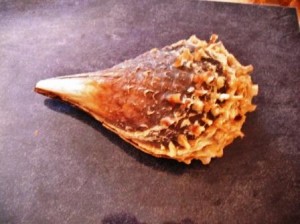 The big shell pictured is from the Pen Shell group, of which we have about 7 different types in the Sea of Cortez. This shell is called the ‘Pinna Rugosa’ from the Family Pinnidae (pen shells); the genus is ‘Pinna’. This particular shell can grow to lengths of 23 inches (though this one was only 15 inches), and can typically be found intertidally to depths of 60 feet, and attaches itself by a very fine fibrous material. This shell is referred to by locals as ‘callo de hache’ or hatchet scallop. It is a much sought after shell by local Mexican divers due to the food source it produces — a large and delicate piece of scallop that is to die for either fried, sautéed, or in ceviche. Our Mexican friends actually have several methods of preparing scallops, though that’s not what makes this shell so interesting to me.
The big shell pictured is from the Pen Shell group, of which we have about 7 different types in the Sea of Cortez. This shell is called the ‘Pinna Rugosa’ from the Family Pinnidae (pen shells); the genus is ‘Pinna’. This particular shell can grow to lengths of 23 inches (though this one was only 15 inches), and can typically be found intertidally to depths of 60 feet, and attaches itself by a very fine fibrous material. This shell is referred to by locals as ‘callo de hache’ or hatchet scallop. It is a much sought after shell by local Mexican divers due to the food source it produces — a large and delicate piece of scallop that is to die for either fried, sautéed, or in ceviche. Our Mexican friends actually have several methods of preparing scallops, though that’s not what makes this shell so interesting to me.
Two things fascinate me about these pen shells. One is that when my Mexican diver friends were showing me their cleaning methods, they pointed out that in each and every shell lives a pair of small shrimp which spend their lives in the comfort and shelter of the pen shell feeding on small particles and algae that enter the opening of the pen. Because the shell is so fragile, it buries itself in the bottom with only a small portion of the upper wide part of the shell exposed for opening and closing while feeding.
The second fascinating fact about this shell is its rich archaeological history. According to Keen (1992), the fibrous tissue that attaches to the bottom is referred to as the “byssus” which was first noted by Aristotle, a Greek naturalist, who used the term to describe how the scallop attached itself “at depth”. Later, according to Keen, a Dutchman coined Aristotle’s term byssus as being abyssal meaning without bottom or “very deep”. During the Middle Ages, according to Keen, “a translation was made of Aristotle’s work, the translator, being no naturalist, missed the point and decided that Aristotle had said the shell was anchored by a ‘byssus’, thus creating the Greek word for depth which actually, today, refers to a molluscan structure!” I love this stuff.
The final attribute of this shell that is also archaeological in nature was the use of the very fine golden-brown fibers of the shell to weave “legendary cloth-of-gold, a fabric that must have rivaled our finest synthetics” (Keen, 1992, p.76). However, because the production of the ‘gold thread’ was so labor-intensive, only the very wealthy could afford this material (usually Royalty). According to Hupp and Malone (an excellent edition of sea life, “The Edge of the Sea of Cortez”, University of Arizona Press, Tucson, AZ, 2008), ancient cultures in both Egypt and Italy wove the thread to make sea silk. They note, however, that “no record of this craft occurs in the Gulf area, though pens are collected for food.” (Hupp and Malone, p.66, 2008).
Several authors, including Keen and Dancer, indicate that the pens are primarily in or on mudflats. Based on our diving experiences, we have noted that these shells can also be found in sandy bottoms, usually in bays or the protected sides of reefs.
Tent Olive
 This week’s presentation is the Tent Olive, another of the gastropod group, family Olividae, species Oliva porphyria. This shell, while not uncommon, is difficult to find on beaches, though it is a reasonably heavy shell as well as being the largest in the Olive family. As can be seen from the photograph, there are unique markings on this shell that are white tent-like in appearance. According to Dance (2002, p.156 Peter Dance, “Shells” by Smithsonian Handbooks), the markings are a “fortuitous result of the animal secreting pigments at the edge of its outer lip throughout its growing period”. The range of this critter is from the Sea of Cortez to Panama and can be found in the intertidal zones, though this particular shell was recovered (uninhabited) from Ensenada Grande, or Punto San Pedro, about 10 miles above La Manga, in about 40 feet of water. The length of this particular find is about 3 inches and it has a width of about 1.5 inches.
This week’s presentation is the Tent Olive, another of the gastropod group, family Olividae, species Oliva porphyria. This shell, while not uncommon, is difficult to find on beaches, though it is a reasonably heavy shell as well as being the largest in the Olive family. As can be seen from the photograph, there are unique markings on this shell that are white tent-like in appearance. According to Dance (2002, p.156 Peter Dance, “Shells” by Smithsonian Handbooks), the markings are a “fortuitous result of the animal secreting pigments at the edge of its outer lip throughout its growing period”. The range of this critter is from the Sea of Cortez to Panama and can be found in the intertidal zones, though this particular shell was recovered (uninhabited) from Ensenada Grande, or Punto San Pedro, about 10 miles above La Manga, in about 40 feet of water. The length of this particular find is about 3 inches and it has a width of about 1.5 inches.
Clam shell Megapitaria aurantiaca, locally known as the almejas chocolate, or chocolate clam
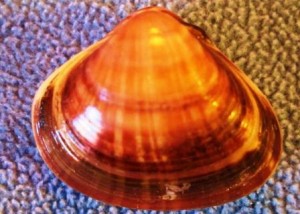 This week’s shell is the clam shell Megapitaria aurantiaca, locally known as the almejas chocolate, or chocolate clam. Being a clam it is from the Pelecypoda Class, Family-Venerida, and sub-family Pitarinae. This clam is known to grow to over four inches, though the pictured specimen only measures 3 and 1/8 inches in width. The chocolate clam can be found only on the west sides of Mexico, though range from the head of the Gulf of California to Salinas, Ecuador. They live in extremely low water to offshore depth of 30-35 feet and prefer a sandy or muddy bottom. They are siphon feeders and bury themselves in the sand from depths of 3-5 inches.
This week’s shell is the clam shell Megapitaria aurantiaca, locally known as the almejas chocolate, or chocolate clam. Being a clam it is from the Pelecypoda Class, Family-Venerida, and sub-family Pitarinae. This clam is known to grow to over four inches, though the pictured specimen only measures 3 and 1/8 inches in width. The chocolate clam can be found only on the west sides of Mexico, though range from the head of the Gulf of California to Salinas, Ecuador. They live in extremely low water to offshore depth of 30-35 feet and prefer a sandy or muddy bottom. They are siphon feeders and bury themselves in the sand from depths of 3-5 inches.
This clam is an extremely popular item in many local restaurants, both locally here in San Carlos and abroad. General uses include, but are certainly not limited to, clam chowder, ceviche, open-shell barbecue, etcetera. Chocolates are generally harvested by local panga divers using air compressors/hoses and by some snorkel and scuba divers.
Dove Shells
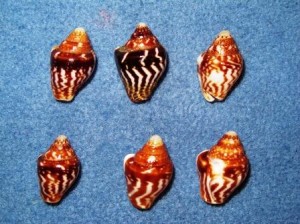 These shells come from the Dove Family a.k.a. Columbellidae. This is a significantly large family with some 42 genera and several hundred species globally with 18 genera and about 76 distinct species in our general area. As notes Knopf, (National Audubon Society Field Guide to North American Seashells, 1981, p. 535) “though the feeding habits of most of the species are unknown, it has been suggested that the Columbellinae are herbivores that feed on algae.” Knopf notes the cousin subfamily “Pyreninae” are carnivores and feed on minute marine life and mollusks.
These shells come from the Dove Family a.k.a. Columbellidae. This is a significantly large family with some 42 genera and several hundred species globally with 18 genera and about 76 distinct species in our general area. As notes Knopf, (National Audubon Society Field Guide to North American Seashells, 1981, p. 535) “though the feeding habits of most of the species are unknown, it has been suggested that the Columbellinae are herbivores that feed on algae.” Knopf notes the cousin subfamily “Pyreninae” are carnivores and feed on minute marine life and mollusks.
Length on these cute little shells ranges from ½ to 1 ½ inches. The photo depicts shells that are 1 ¼ inches. The shells, Columbella strombiformis, are the largest of the West American Columbellas and range from Gulf of California (Sea of Cortez) south to Peru. The Dove shells tend to live in sandy areas where there is abundant turtle kelp and algae and boldly stroll along the surface. They are also known to hide under rocks in the intertidal zones. With high tides and storms these shells can be found virtually by the hundreds in sandy areas. Many hit the beach undamaged with an exceptional variation in both color and form. While common, this shell is sought after for its variations and color combinations.
These shells require little cleaning and preservation as the sandy areas they thrive in tend to keep the shell fairly glossy and colorful.
Tower shells
 This week’s shell is the Turritella Torrecilla, a.k.a. the Tower shells from the Family Turritellidea, sub-family Turritellinae, Turritella, genus Turritella. This shell is easily confused with the Terebridae family, or, the ‘augur’ shell. The easiest way to tell the difference is that the shells pictured here, from the Turritellidea Family, have a short and, for the most part, circular opening (canal) at the base whereas the Terebridae family tend to have elongated canals at the base that are both longer and angular. There are two Panamic sub-families of this shell, the Turritellinae containing many species, and the Vermiculariinae containing only two Panic genera. The Tower shells tend to dwell in the sandy areas just slightly below the surface and feed on seaweed and broken bits of coral, shell, and other substrate items that are available. Most of these shells live below the low-tide line.
This week’s shell is the Turritella Torrecilla, a.k.a. the Tower shells from the Family Turritellidea, sub-family Turritellinae, Turritella, genus Turritella. This shell is easily confused with the Terebridae family, or, the ‘augur’ shell. The easiest way to tell the difference is that the shells pictured here, from the Turritellidea Family, have a short and, for the most part, circular opening (canal) at the base whereas the Terebridae family tend to have elongated canals at the base that are both longer and angular. There are two Panamic sub-families of this shell, the Turritellinae containing many species, and the Vermiculariinae containing only two Panic genera. The Tower shells tend to dwell in the sandy areas just slightly below the surface and feed on seaweed and broken bits of coral, shell, and other substrate items that are available. Most of these shells live below the low-tide line.
There are several beaches, more or less locally, where you can find an abundance of these shells washed up on the beach. The pictured shells were collected at Cochorit Beach, south of Empalme about 10 miles. The beach is well signed and easy to locate. The amazing thing about this beach is that the shells are so numerous that people drive and walk over them as though they were just a walking base. There are virtually thousands of these shells, as well as many others, including Augurs, that wash up and are largely ignored year round with the exception of an occasional collector. The beach is flat and you can wade into the water for over a hundred yards and still only be about 4-6 feet deep. Below, one can see large and undamaged, though non-living, specimens of these shells rolling around in the surf and in excellent condition.
Cochorit beach, during this time of the year, is virtually uninhabited by people, though, on weekends you will find a few folks, primarily Mexican, sharing the beach with you. They are very friendly and gregarious and the beach is an extremely ‘watched’ and safe beach to venture onto and a beautiful place to visit. There are about 2-3 miles of open beach and bathrooms are available at the entrance.
Panama False Olive
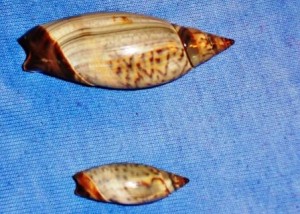 This week’s shell is from the large family Olividae, genus Agaronia, and sub-genus Oivella, and the pictured Agaronia testacea (S. Peter Dance, “Shells”, Smithsonian Handbooks, 2002, p. 160).
This week’s shell is from the large family Olividae, genus Agaronia, and sub-genus Oivella, and the pictured Agaronia testacea (S. Peter Dance, “Shells”, Smithsonian Handbooks, 2002, p. 160).
These shells run to about 1 ½ inches (4 cm) in length and about ¾ inches in height and width. The pictured shell is 1 ¾ inches in length. Their habitat is generally in the inter-tidal sandy areas and range from the Sea of Cortez to Peru. These specimens were obtained uninhabited along the beach in front of the Paradiso Hotel-Resort at low tide. Live specimens can actually be photographed in as little as 2 meters (about 6 feet) of water by looking for trails in the sand. They move just below the surface of the sand and leave easy-to-read trails. They are generally about an inch or so below the surface of the sand and have two wide lobes of the foot and mantle that fold back over the shell, as do most Olives that protect their polish and brilliance as they shuffle along beneath the sand. Though the shell is beautiful, it is a predatory and carnivorous animal. Moreover some of these critters even eat their own (a bit of canibalism in this family!)
One fascinating fact about the Olive family is that there are more species in the American tropics than in any other part of the world and it has it’s metropolis in the western Pacific (Keen, M., 1992, Sea Shells of Tropical West America p. 622).
Turridae Family, Knefastia olivacea
 The pictured shell comes from the Turridae Family and Turriculinae sub-family, genus, “Knefastia”, and specifically Knefastia olivacea. We are not currently aware of any common names for this shell except “a Turrid”. As notes Keen (1992, Sea Shells of Tropical West America, p. 687), the entire Turridae Family has gone through a century of changes in classifications and identifications and the splitting of the categories in the current 20th and 21st centuries. She notes that there are now (as of 1992), “some 550 generic and sub-generic names now available, and the end is not in sight.” Much of the splitting has occurred due to organic differentiations and some to form and structure differences as well. Moreover, within the Turrid family, many live in shallow waters and some have been found in what she (Keen) refers to the deep cold water abyss, and, not all are tropical in their habitat. For the above reasons Keen also notes that there is still a great deal of confusion in this family and that correct identification and classification is not always a certainty. One thing is clear, all are predators.
The pictured shell comes from the Turridae Family and Turriculinae sub-family, genus, “Knefastia”, and specifically Knefastia olivacea. We are not currently aware of any common names for this shell except “a Turrid”. As notes Keen (1992, Sea Shells of Tropical West America, p. 687), the entire Turridae Family has gone through a century of changes in classifications and identifications and the splitting of the categories in the current 20th and 21st centuries. She notes that there are now (as of 1992), “some 550 generic and sub-generic names now available, and the end is not in sight.” Much of the splitting has occurred due to organic differentiations and some to form and structure differences as well. Moreover, within the Turrid family, many live in shallow waters and some have been found in what she (Keen) refers to the deep cold water abyss, and, not all are tropical in their habitat. For the above reasons Keen also notes that there is still a great deal of confusion in this family and that correct identification and classification is not always a certainty. One thing is clear, all are predators.
These shells, olivacea, were found in the sandy sledge area of the canal that enters the lagoon between Soggy Pesso and Hotel Paradiso. Live specimens of this shell are covered with an olive-green exterior and when cleaned up the shell is a tawny orange with narrow bands of brown across the base. As can be seen from the photo, this shell can also have brown highlights at its peak. Lengths can be up to 62 mm with diameters up to 23 mm. Keen states that this shell can be found from Guaymas Mexico to La Libertad Ecuador, at low tide and to depths of 50 meters or around 150 feet. The shells above demonstrate the difference in appearance of not-cleaned, and cleaned. Though the process is exceptionally slow, cleaning this particular shell is worth the effort. For questions or suggestions on these and any other shells please contact us directly at alchip692@msn.com. Again, if you have photos or your own shells, please, feel free to share them with our shell collectors community at the above email address.
Oliva incrassata
 This week’s shell is the Oliva incrassata, and yes, it’s in the olive shell family, or more specifically. the family Olividae. This is an interesting family in that according to Keen (1992), this little dude eats its own! It is a beautifully bright shell that maintains its high-polished tone due to a double mantel that protects the outer shell when it is moving through the sand. You will generally find these critters in sandy bottoms and they leave a distinct trail in the sand, or have become uninhabited by either an octopus or one of their cousins. According to Keen, this specie, carnivorous, plows through the sand but while doing so, extends a filament, which also has a sensory function. Apparently, there are more species of the Olivella in the American tropics than in any part of the world and that the ‘metropolis of the Olivella is in the western Pacific, i.e. Sea of Cortez and other semi-tropical waters.
This week’s shell is the Oliva incrassata, and yes, it’s in the olive shell family, or more specifically. the family Olividae. This is an interesting family in that according to Keen (1992), this little dude eats its own! It is a beautifully bright shell that maintains its high-polished tone due to a double mantel that protects the outer shell when it is moving through the sand. You will generally find these critters in sandy bottoms and they leave a distinct trail in the sand, or have become uninhabited by either an octopus or one of their cousins. According to Keen, this specie, carnivorous, plows through the sand but while doing so, extends a filament, which also has a sensory function. Apparently, there are more species of the Olivella in the American tropics than in any part of the world and that the ‘metropolis of the Olivella is in the western Pacific, i.e. Sea of Cortez and other semi-tropical waters.
With regards to the incrassata, the shell is heavy and well protected and coloration can range from a creamy white background with zigzag patterns of markings, some are tinted pink, and others are fawn colored. The spotted parts tend to be brown and scattered as can be seen in the photo. The size ranges from 55 mm in length to diameters of 30 mm, though in our experience, we have encountered species of up to 3 inches. According to Morris (1980), there are some species of the incrassata that one occasionally comes across that are a pure yellowish color with no marks, and these “Golden olives” are fairly rare. This, however, has not been confirmed by other authors — nor have we encountered this shell. If you do, don’t put it in someone’s Christmas stocking, as it may be valuable!
The range of this shell is from Magdalena Bay, Baja California, Sea of Cortez and down to Peru. They can often be encountered on the outer side of sandpits in shallow water to sand traps at low tides. This specie is extremely plentiful and uninhabited species can usually be found in areas of deserted beaches and tide-pools.
Auger shell Family
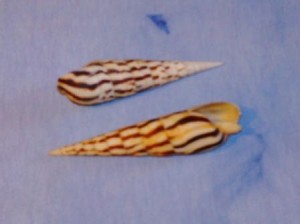 This week’s shell is again from the mollusk class, specifically the Auger shell Family, Terebridae, genus Terebra. This particular shell goes by the name of Terebra strigata, locally referred to as the Zebra or Flame conch. According to H. A. Rehder (National Audubon Society Field Guide to North American Seashell, 1981), there at least 6 genera and 150 species in this group, all of which like warm water and sandy bottoms — hard to argue with that! Shell sizes range from one-half inch to almost 9 inches. As can be seen from the photo, this little shell is about 3 and ¾ inches and can be found intertidally to 55 meters in depth. Note the extensive small foot and mouth with a ‘well developed proboscis’ (Rehder, p.611) — or nose. The feeding habits of the shells in this family vary; some have radular teeth and pierce their victims while releasing a poison from a gland and they feed almost exclusively on marine worms. The shells without teeth use their extensive proboscis and feed on slow-moving wormlike marine animals, engulfing them with the proboscis.
This week’s shell is again from the mollusk class, specifically the Auger shell Family, Terebridae, genus Terebra. This particular shell goes by the name of Terebra strigata, locally referred to as the Zebra or Flame conch. According to H. A. Rehder (National Audubon Society Field Guide to North American Seashell, 1981), there at least 6 genera and 150 species in this group, all of which like warm water and sandy bottoms — hard to argue with that! Shell sizes range from one-half inch to almost 9 inches. As can be seen from the photo, this little shell is about 3 and ¾ inches and can be found intertidally to 55 meters in depth. Note the extensive small foot and mouth with a ‘well developed proboscis’ (Rehder, p.611) — or nose. The feeding habits of the shells in this family vary; some have radular teeth and pierce their victims while releasing a poison from a gland and they feed almost exclusively on marine worms. The shells without teeth use their extensive proboscis and feed on slow-moving wormlike marine animals, engulfing them with the proboscis.
The pictured shells were collected (uninhabited) in front of Soggy Peso on the south side of Isla Venado in about 10 feet of water. We have seen many of these shells washed up on the beach in many locations locally but the quality is generally less than perfect. Another great area for this and other auger shells is on the north side of the estuary Soldado — be careful not to cross into the Soldado side as it is a marine-life sanctuary.
Scallop Shell (Lyropecten subnodosus)
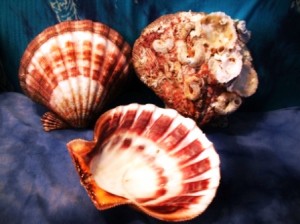 This week’s shell is the Shell sign on every gas station in America, referred to as the Scallop Shell, locally known as the Mano de Leon (Lion’s Paw), and technically the Lyropecten subnodosus. As the pictures shows, the shell is extremely distinct, colorful, and can often be a multiple-ecosystem in and of itself. These shells normally reside in sandy areas where there is good current (for filter-feeding purposes) and are generally encountered at depths of 60 feet plus. They can reach lengths of 7” and widths of 5”. You can sometimes find them at the beach, but the best source is local fish/diver camps. They usually need considerable cleaning to look like the pictured shells.
This week’s shell is the Shell sign on every gas station in America, referred to as the Scallop Shell, locally known as the Mano de Leon (Lion’s Paw), and technically the Lyropecten subnodosus. As the pictures shows, the shell is extremely distinct, colorful, and can often be a multiple-ecosystem in and of itself. These shells normally reside in sandy areas where there is good current (for filter-feeding purposes) and are generally encountered at depths of 60 feet plus. They can reach lengths of 7” and widths of 5”. You can sometimes find them at the beach, but the best source is local fish/diver camps. They usually need considerable cleaning to look like the pictured shells.
The Mano de Leonis much sought after by local divers for the scallop meat contained inside, and readily sold to local restaurants and fish stores. The good news is that most local commercial divers don’t dive below 65-70 feet so if you are willing to ‘jump it’, you can see these shells up close and personal at 70+ feet. Just find a current and follow it to the sand. They basically look like rocks down there and are generally covered with plants, sea life, and multiple ecosystems including sea-tube worms, smaller species in the scallop family, and even some Spondylus members. The meat they contain is extremely large and tasty, as well as being of significant commercial value. I recommend light cooking with a bit of Muscato or Gurvertztraminer wine and butter. Scallop, Mano de Leon, is a true delicacy and unique specie in our area of paradise.
Cardiidae
 This week’s specimen is the scaly cockle from the bi-valve group. The family name is Cardiidae, cockles, genus Trachycardium , subgenus, Trachycardium Consors. This shell can be found all over the Sea of Cortez. Generally, it resides in shallow sandy water. Keen (1992) has reported that some of these shells have been dredged from depths of 45 meters and have also been found in the Galapagos Islands. Our observations have been that they tend to be in 20-40 feet, and can often be collected on sandy beaches where there are no rocks to damage them. The above shell was found on the beach in front of the Algodones sand dunes.
This week’s specimen is the scaly cockle from the bi-valve group. The family name is Cardiidae, cockles, genus Trachycardium , subgenus, Trachycardium Consors. This shell can be found all over the Sea of Cortez. Generally, it resides in shallow sandy water. Keen (1992) has reported that some of these shells have been dredged from depths of 45 meters and have also been found in the Galapagos Islands. Our observations have been that they tend to be in 20-40 feet, and can often be collected on sandy beaches where there are no rocks to damage them. The above shell was found on the beach in front of the Algodones sand dunes.
Being a member of the bi-valve family, the scaly cockle too, is a syphon feeder — i.e., it filters in sediment and algae with one syphon and elimination and movement with the other. It has been reported by some that these shells can literally fly underwater from one location to the next, though we have not seen this personally. They are usually, however, directly on the surface of the sandy bottoms and are easily observed. Moris (1982) reports these shells can grow to lengths of 2 ½ inches. The shell in the photo measures 2 and 3/8 inches in length and 2¼ inches in height and required little cleaning. In terms of the cockle group they are much sought out by both restaurants and individuals who enjoy clam chowder.
giant Red Abalone (Haliotis rufescens)
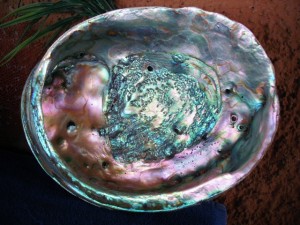 Welcome to the giant Red Abalone, a.k.a. Haliotis rufescens, from the Family Haliotidea and still in the Gastropod class. While we seldom cover shells not from the Sea of Cortez, this specimen was truly worthy of both mention and presentation. The red abalone, one of several varieties of abalone, is listed as one of the largest in the gastropod family, and singularly the largest in the Haliotidea family. Until the last few years there were many commercial industries founded on the procurement and sale of abalone. Today, however, there are very few abalone industries due to the Sea Otter and over-harvesting.
Welcome to the giant Red Abalone, a.k.a. Haliotis rufescens, from the Family Haliotidea and still in the Gastropod class. While we seldom cover shells not from the Sea of Cortez, this specimen was truly worthy of both mention and presentation. The red abalone, one of several varieties of abalone, is listed as one of the largest in the gastropod family, and singularly the largest in the Haliotidea family. Until the last few years there were many commercial industries founded on the procurement and sale of abalone. Today, however, there are very few abalone industries due to the Sea Otter and over-harvesting.
The meat in the abalone is considered to be one of the world’s greatest delicacies when prepared properly. Though abalone can still be obtained commercially it is extremely expensive. It can, however, still be found in northern California though it is illegal to get them with tanks/regulators. You must ‘skin-free dive’ for them with single-breath-hold diving techniques and in extremely cold waters. The effort, however, is well worth it.
When first born, the abalone are free-swimmers and then attach themselves to rocks in areas where the kelp and eel-grass are plentiful. The red abalone can be found in depths ranging from 2 feet at low tide to 60 feet and that’s a long way to go on a single-breath free-dive. Though Morris (Pacific Coast Shells, 1980, p. 53) mistakenly describes size and range of habitat, the world’s record for a red abalone is 12 inches in length, and ranges from Humbolt County, Northern California to the north pacific coast of Mexico. Average size, generally is about 8 inches though the above specimen is 10 ¼ inches and produced almost 3 pounds of meat. There is also one species of abalone in Hawaii though the specie is very small in size (approximately 1-2 inches in length). Several species of abalone can also be found in Korea, Japan, and off the coast of China where there is cold water and kelp/eel grass and in the generally same latitude as California and Northern Mexico on the pacific side. The most common species in these areas are the red, green and black abalone. Currently there are several abalone “farms” in California and the specie is well monitored and protected by the California Department of Fish and Game. A special license is required to obtain them with strict size and number (3 in possession) limitations.
Spiny Venus (Pitar lupanaria)
 Shell: ‘Spiny Venus’ also known “Pitar lupanaria, of the clam class Pelecypoda, family ‘Veneridae’ (Venus), sub-family Pitarinae.
Shell: ‘Spiny Venus’ also known “Pitar lupanaria, of the clam class Pelecypoda, family ‘Veneridae’ (Venus), sub-family Pitarinae.
According to Keen “From the standpoint of color, beauty of form, and diversity, the Venus clams are the most advanced of the bivalves.” This has certainly been my experience as a collector. As can be seen from the photo, this specie has long delicate spines on both sides with a purple/white high gloss finish. One wonders how this creature even moves around with all that armor.
These shells are plentiful and can best be obtained on many sandy beaches after a heavy storm. I recommend Topolobampo as an undisturbed and isolated area for beach-comers. We have obtained fully intact specimens from sandy beaches south of Guaymas down to Huatabambito.
Keen lists the areas from Ballenas Bay, West Coast Sea of Cortez and further south to Negritos, Peru.
Keen also mentions that the key is sandy beaches after storms though she also states they can be found in waters of up to 24 meters.
The shells average 2-3 inches in length and 1-2 inches in width.
Murex Recurvirostis Tricoronis
 The shell is from the Murex group though it bears little resemblance to the normal Murex crowd. This shell is the Murex Recurvirostis Tricoronis. A beautiful specimen to be sure, and, as a member of the Murex family shares the same eating habits as its cousins in the Murex genus. It basically is a predator of smaller gastropods. Keen (1992, p.514, plate 978) states the range of this shell as being from the Sea of Cortez to Ecuador and lists it as a sub-genus in the Murex group. Keen states that it can be found in depths to 75 meters. Average measurements are 50 mm in length and 25 mm in diameter.
The shell is from the Murex group though it bears little resemblance to the normal Murex crowd. This shell is the Murex Recurvirostis Tricoronis. A beautiful specimen to be sure, and, as a member of the Murex family shares the same eating habits as its cousins in the Murex genus. It basically is a predator of smaller gastropods. Keen (1992, p.514, plate 978) states the range of this shell as being from the Sea of Cortez to Ecuador and lists it as a sub-genus in the Murex group. Keen states that it can be found in depths to 75 meters. Average measurements are 50 mm in length and 25 mm in diameter.
Murex elenensis
 This week’s shell is first cousin to the shell presented last week. Both are in the genus Murex and though this shell is the Murex elenensis, still in the gastropod family. The shell pictured was found about 100 yards south of Soggy Peso in a clump of seaweed and sand. This specimen has a length of 2”, width of 1” and height of 1”. There are far more spines on this shell and they are extremely delicate. The elenensis is also a predator and feeds on smaller shells. The best areas for finding this shell intact are sandy beaches that are absent of rocks and reefs. This specimen, like the Murex recurvirostris tricoronis presented last week can be found and photographed in waters up to 75 meters. The range of habitation is from Baja California, Gulf of California and south to Ecuador.
This week’s shell is first cousin to the shell presented last week. Both are in the genus Murex and though this shell is the Murex elenensis, still in the gastropod family. The shell pictured was found about 100 yards south of Soggy Peso in a clump of seaweed and sand. This specimen has a length of 2”, width of 1” and height of 1”. There are far more spines on this shell and they are extremely delicate. The elenensis is also a predator and feeds on smaller shells. The best areas for finding this shell intact are sandy beaches that are absent of rocks and reefs. This specimen, like the Murex recurvirostris tricoronis presented last week can be found and photographed in waters up to 75 meters. The range of habitation is from Baja California, Gulf of California and south to Ecuador.














